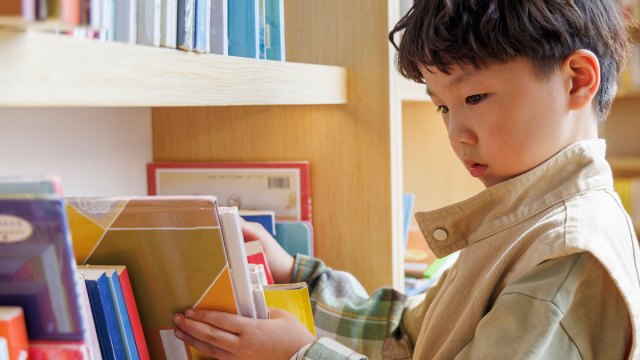When my parent friends say they are “decluttering” their homes and set their sights on stacks of children’s books, I gently urge them to stop—or at least slow down. I’m a school librarian, so maybe I’m a natural hoarder, but my experience working in education has shown me that the Marie Kondo method—eliminating everything that doesn’t spark immediate joy—doesn’t translate to our bookcases.
Raising readers is more than pushing kids to the next level, discarding books as we go. To help our kids build a lifelong love of reading, we need to grow home libraries (even small ones). Go ahead, donate all those old toys and clothes, but your kid will never outgrow The Very Hungry Caterpillar.
When I work with high school students, I always ask them on the first day what books they remember reading as kids. The students who gush about Elephant and Piggy or Goodnight Gorilla are often my strongest achievers, and, perhaps more importantly, the ones who love to learn. Research shows that pleasure-reading increases students’ general academic achievement—not only in English or language arts but in math as well.
Related: When You Love to Read but Your Kids Don’t
Nostalgia-reading can also be a security blanket during stressful times, and returning to well-loved books can cement our identities. We look back at books to remember who we used to be, to understand our own growth. You don’t have to save everything, but why not honor our children’s reading journeys with a few representative titles?
Here’s how I organize my children’s library collection so it doesn’t crowd my 800-square-foot New York apartment (though these tips still apply to those with a bit more elbow room):
Put favorite books at eye level
I use the Dewey Decimal system professionally, but at home, I arrange my shelves more like a bookstore. The “New Releases”—books we’ve just bought or borrowed from the library—go on the lowest shelves, and the older, less enticing books move up top.
I put new books with their covers outward-facing, like a bookstore display. If I rotate these selections regularly (whenever I find the time or once a month), I catch my daughters’ attention. The eye-level shelf is where you advertise books; the top shelves are for storage.
Use school shelving and book bins
To make books really accessible to early walkers, toddlers, and preschoolers, buy a school-style bookcase where books will turn outward. These shelves take up space, but isn’t reading important enough to deserve that square footage?
Colorful book bins or baskets on the floor can also offer the littlest ones the hands-on experience of choosing books. The smaller the child, the lower to the floor books should be, like low-hanging fruit.
Swap books with friends
My 10-year-old reads her graphic novels and series books so quickly that we would never be able to keep them all on the shelf. But she re-reads many of them—and re-reading is shown to be an important part of literacy—so we don’t want give them all away. That’s why we swap our series books with other kids. Sometimes my daughter’s friends keep her books for several months, and they seem new and exciting again. She often re-reads them immediately after getting them back.
You can also put books in a basement or offsite storage and then reintroduce them. I probably own 1,000 books but only have 500 in my apartment. Many of them live in storage or at friends’ houses. As great as it is to surround yourself with books, it’s also important to take breaks as you would from a loved one. This makes reunions all the sweeter.
Borrow from and donate to Little Free Libraries
I confess that when we get some titles back, they have simply lost their luster. We just don’t feel the spark. This is when we jump at the chance to share the books with our community and donate them to thrift shops, libraries, or Little Free Libraries. Use this Little Free Library finder to see if there’s one near you and to learn how to create your own. After all, you probably need some space at home to do other things besides reading!
Jess deCourcy Hinds (jessdecourcyhinds.com) is a writer and librarian. Sign up for her free quarterly newsletter, I’m an Open Book: On Love, Libraries and Life-building.
